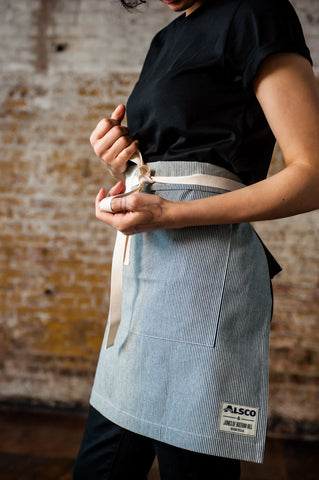The Ultimate Guide to Choosing the Perfect Apron
Are you tired of searching for the perfect apron that meets all your work needs? Look no further! In this ultimate guide, we unveil the secrets to selecting the ideal apron for every worker. Whether you're a chef, a carpenter, a hairstylist, or even a painter, we've got you covered.
Aprons are no longer just a piece of fabric; they have become a vital tool in enhancing productivity, safety, and style in various industries. Our team researched and tested many aprons to give you detailed and helpful information.
From choosing the right material for durability and comfort, to selecting the perfect design and features for your specific tasks, we leave no stone unturned. So, if you're ready to upgrade your workwear game and find the apron that will make you stand out from the crowd, let's dive in and discover the ultimate guide to choosing the perfect apron for every worker.

Importance of aprons in the workplace
Aprons play a crucial role in various industries, providing protection and functionality to workers. In the culinary world, chefs rely on aprons to shield their clothing from spills, stains, and heat. Not only do aprons keep the chef's attire clean, but they also contribute to a professional appearance.
Similarly, carpenters and craftsmen wear aprons to keep their tools within reach and protect themselves from sharp objects and debris. Aprons are often used in hair salons to shield hairstylists' clothes from chemicals and hair clippings. Aprons are used by painters and artists in the art industry to protect their clothes from paint splatters and stains.
When it comes to safety, aprons are designed to provide an extra layer of protection. In industrial settings, aprons made from flame-resistant materials can protect workers from sparks, flames, and chemicals. In medical and laboratory environments, aprons made from fluid-resistant materials help to maintain a hygienic workspace. Aprons also serve as a visible symbol of professionalism and competence, instilling confidence in customers and clients.
Aprons are important tools for productivity, safety, and professionalism in different industries, not just fashion statements.
Types of aprons for different industries
Aprons come in a variety of styles and designs, each catering to the specific needs of different industries. Let's take a closer look at some of the most common types of aprons available:
1. Bib Aprons: Bib aprons are the most popular type, and they provide full coverage for the upper body. They feature a bib that extends from the chest to the waist, offering protection to the front of the body.

2. Waist Aprons: Waist aprons are worn around the waist and are used in industries where easy access to tools or supplies is necessary. They are shorter than bib or cobbler aprons, which makes them perfect for waitstaff, bartenders, and retail workers.

3. Bistro Aprons: Bistro aprons are a more stylish option, often featuring a cross-back design and longer length. Servers and hosts in the hospitality industry often wear them to make their outfits look more elegant.

4. Cobbler Aprons: Cobbler aprons, also called smock aprons, are great for industries needing full front and back coverage. These aprons wrap around the body and typically have ties on both sides, allowing for easy adjustment and a secure fit.
5. Butcher Aprons: Butcher aprons are heavy-duty aprons made from durable materials such as leather or heavy cotton. They protect the entire body, including arms and legs, and are commonly worn in industries with sharp tools or hazardous substances.
Every industry has specific needs. Picking the correct apron is crucial for comfort, usefulness, and safety.
FACTORS TO CONSIDER WHEN CHOOSING AN APRON
When selecting an apron, there are several factors to consider to ensure you choose the perfect one for your specific needs. Let's explore these factors in detail:
1. Material: Aprons are available in a wide range of materials, including cotton, polyester, denim, leather, and more. The material you choose should depend on the nature of your work and the level of protection required. Lightweight aprons are typically made from cotton and polyester, whereas durable and protective aprons are crafted from leather and robust fabrics.
2. Comfort: Comfort is of utmost importance when it comes to workwear. Look for aprons with adjustable straps, breathable fabrics, and ergonomic designs that allow for ease of movement. Consider features such as padded neck straps or cross-back designs to distribute weight evenly and reduce strain on the neck and shoulders.
3. Functionality: Evaluate your work tasks and identify the specific features you require in an apron. For example, if you need easy access to tools or utensils, look for aprons with multiple pockets or compartments. If you work in a fast-paced environment, consider aprons with quick-release buckles or adjustable closures for easy removal.
4. Apron Style: While functionality is important, style should not be overlooked either. Choose an apron that reflects your personal taste and complements the overall aesthetic of your work environment. Consider color options, patterns, and customizable features to add a touch of individuality to your apron.
5. Durability: Depending on the nature of your work, your apron may be subjected to regular wear and tear. Look for aprons with reinforced stitching, sturdy fabrics, and easy-care instructions to ensure longevity. Consider aprons with stain-resistant or water-resistant properties if you work in an environment prone to spills or splashes.
By considering these factors, you can narrow down your options and find the apron that best suits your needs and preferences.
APRON MATERIALS AND THEIR ADVANTAGES
Aprons are available in a variety of materials, each offering unique advantages and characteristics. Let's take a closer look at some of the most common materials used in apron manufacturing:
1. Cotton: Cotton is a versatile and widely used material for aprons. It is lightweight, breathable, and comfortable to wear for extended periods. Cotton aprons are easy to clean and maintain, making them a popular choice in industries such as hospitality and healthcare.
2. Polyester: Polyester aprons are strong and don't wrinkle or shrink. They are sometimes mixed with cotton for extra comfort and breathability. Polyester is stain and chemical resistant, making it great for industries needing aprons that can handle spills and harsh substances.
3. Denim: Denim aprons offer a stylish and rugged option for industries such as carpentry and art. Denim is a heavy-duty fabric that provides excellent durability and protection.
4. Leather: Leather aprons are the epitome of durability and protection. They offer superior resistance to heat, flames, and punctures, making them ideal for industries such as welding or metalworking. Leather aprons are also highly durable and can withstand long-term use without significant wear and tear.
It's important to consider the advantages and disadvantages of each material when choosing an apron. Assess the specific requirements of your work environment and select the material that best aligns with your needs.
CHOOSING THE RIGHT APRON STYLE
Apron styles vary greatly, and selecting the right one depends on your industry, job requirements, and personal preferences. Let's explore some popular apron styles and their unique characteristics:
1. Cross-back aprons: Cross-back aprons, also known as crisscross aprons, feature straps that cross at the back, distributing the weight evenly across the shoulders. This design reduces strain on the neck and provides a secure fit. Cross-back aprons are popular in industries that require extended periods of wear, such as bartending or woodworking.
2. Adjustable strap aprons: Adjustable strap aprons allow for easy customization and provide a comfortable fit for individuals of different sizes. Aprons have buckles or sliders to adjust strap length for a better fit. Adjustable strap aprons are versatile and suitable for a wide range of industries.
3. Wrap-around aprons: Wrap-around aprons provide full coverage and protection to the front and back of the body. They typically feature waist ties that secure the apron in place. Industries that involve messy or hazardous tasks, such as food processing or laboratory work, commonly use wrap-around aprons.
4. Split-leg aprons: Split-leg aprons, also known as bistro aprons with a bottom split, offer ease of movement and flexibility. These aprons feature a split in the front, allowing for increased mobility while maintaining coverage. Split-leg aprons are popular in industries that need protection and freedom of movement, like serving or bartending.
5. Full-length aprons: Full-length aprons provide maximum coverage, extending from the chest down to the ankles. They offer comprehensive protection against spills, stains, and potential hazards. Industries with tough jobs or exposure to harsh substances, like manufacturing or chemical handling, often use full aprons.
Consider the nature of your work, your range of movement, and the level of coverage required when choosing an apron style. Opt for a style that combines functionality, comfort, and aesthetics to enhance your work experience.
SIZING AND FIT CONSIDERATIONS FOR APRONS
Choosing the right size and achieving the perfect fit is essential to ensure maximum comfort and functionality when wearing an apron. Here are some key sizing and fit considerations to keep in mind:
1. Measurements: Start by taking accurate measurements of your body to determine the appropriate apron size. Measure your waist, chest, and hip circumference, as well as your height. Refer to the manufacturer's sizing chart to find the closest match.
2. Length: Consider the length of the apron, especially if you require coverage for your legs or if you prefer a shorter style. Full-length aprons provide comprehensive coverage, while waist aprons offer more mobility. Choose a length that suits your job requirements and personal preference.
3. Adjustability: Look for aprons with adjustable straps or ties that allow for easy customization. Adjustable features enable you to achieve a secure fit and accommodate changes in body size or clothing layers.
4. Ease of movement: Ensure that the apron provides enough room for movement, particularly in areas such as the shoulders, arms, and legs. A well-fitting apron should not restrict your range of motion or cause discomfort.
5. Consider layering: If you intend to wear the apron over your regular clothing, consider the additional space required for layering. Ensure that the apron is roomy enough to comfortably fit over your attire without feeling tight or constricting.
By considering these sizing and fit considerations, you can select an apron that provides optimal comfort and functionality throughout your workday.
APRON CUSTOMIZATION OPTIONS
Customizing your apron can add a personal touch and reflect your brand identity or individual style. Here are some common customization options to consider:
1. Printing: Many apron manufacturers offer printing services, allowing you to add your logo, name, or custom design to the apron. This customization option is particularly popular in the hospitality industry, where establishments often showcase their brand on aprons worn by staff.
2. Color options: Choose an apron in a color that aligns with your brand or personal preference. Manufacturers have many colors to choose from, so you can find the perfect shade for your work or style.
3. Pocket customization: Aprons with multiple pockets provide ample storage space for tools, utensils, or personal belongings. Some manufacturers offer customization options for pocket placement or size, allowing you to create a layout that suits your specific needs.
4. Strap customization: Consider customizing the straps of your apron with a different color or pattern to add a unique touch. Some manufacturers offer interchangeable straps, allowing you to switch between styles or colors to match different occasions or seasons.
5. Logo placement: Tell the manufacturer where you want your logo on the apron. They will put it in the right place. You can place logos on the chest, bottom hem, or straps.
Customizing your apron not only adds a personal touch but also helps promote your brand or enhance your professional image. Explore the available customization options and find the perfect combination that represents your unique style.
MAINTENANCE AND CARE FOR APRONS
Proper maintenance and care are essential to prolong the lifespan of your apron and ensure its optimal performance. Always refer to the manufacturer's care instructions for specific guidance on washing, drying, and ironing your apron. Different materials may require different care methods to maintain their integrity. Follow the appropriate stain removal techniques for the specific type of stain and fabric. Wash aprons separately or with similar colors to avoid color bleeding or transfer. Whenever possible, hang your apron to dry rather than using a dryer. This helps preserve the
